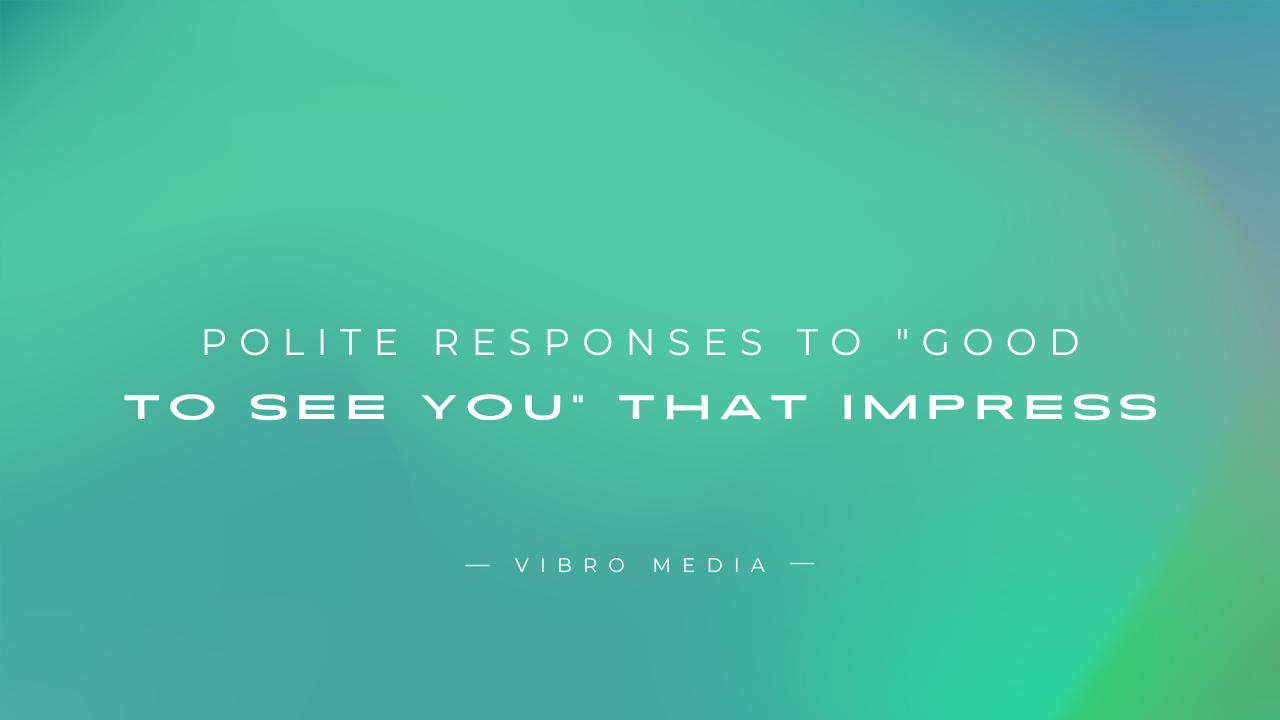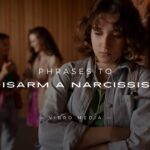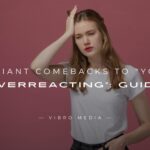Social interactions can sometimes be tricky, especially when you’re caught off guard by a greeting like “Good to see you.” Whether you’re meeting an old friend, a colleague, or even an acquaintance, knowing how to respond appropriately is key to making a positive impression. But don’t worry; this guide will help you navigate those situations smoothly and confidently.
Importance of Social Interactions
How you respond to greetings like “Good to see you” can influence the tone of the entire conversation. A warm and friendly response can build rapport and strengthen your relationships, while a cold or awkward reply can have the opposite effect. Understanding the social cues behind these interactions is essential in today’s fast-paced, connection-driven world.
Understanding the Context
- Formal vs. Informal Situations
Context is everything when it comes to responding to a greeting. Are you at a formal event, a casual gathering, or perhaps meeting someone for the first time? Your response to “Good to see you” should match the setting. A polite and respectful tone is usually best in formal situations, while informal settings allow for more relaxed and friendly responses.
- Tone and Body Language
Your tone and body language say just as much, if not more, than your words. A genuine smile, friendly eye contact, and a warm tone can enhance the simplest responses. Conversely, a monotone voice or avoiding eye contact might make your reply seem insincere.

200+ Responses to “Good to See You”
Polite and Neutral Responses
- It’s nice to see you as well.
- Glad to see you.
- It’s a pleasure to see you.
- I appreciate the warm welcome.
- It’s good to catch up.
- I’m glad we crossed paths.
- Nice to see you, too.
- It’s good to see you here.
- Thank you, it’s nice to see you.
- It’s always pleasant to see you.
Friendly and Warm Responses
- Great to see you! How have you been?
- I’m so happy to see you again!
- It’s always a joy to see you.
- You just made my day by showing up!
- It’s wonderful to see your smile!
- I’ve been looking forward to this!
- Seeing you always brightens my day.
- I’m so glad we could meet up!
- You’re always a welcome sight!
- It’s lovely to see you again!
Casual and Informal Responses
- Hey there! Good to see you!
- Yo, what’s up? Good to see you!
- Hey, nice to run into you!
- What’s up? Good to see you!
- Look who it is! Good to see you!
- Hey, long time no see!
- Good to see you around!
- Hey, nice seeing you here!
- Hey, you made it!
- Good to catch you here!
Enthusiastic Responses
- It’s fantastic to see you! What’s new?
- Awesome, it’s great to see you!
- Super excited to see you!
- Wow, so good to see you!
- I’m thrilled to see you!
- It’s amazing to see you!
- Wonderful to see you!
- So glad to see you! Let’s celebrate!
- I’m pumped to see you!
- I can’t wait to catch up; it’s great to see you!
Playful or Humorous Responses
- Well, look who it is! Aren’t you a sight for sore eyes?
- Did someone order a good time? Because here I am!
- Ah, you found me! Good to see you!
- Are you sure it’s good to see me? I’m quite the handful!
- Wow, I didn’t expect to see you! Lucky day for both of us!
- You’re here! I was just thinking I needed some company.
- Good to see you! I promise I’m not as boring as last time.
- Fancy running into you here! It must be fate.
- Look who decided to show up! Good to see you, troublemaker.
- You’re not a mirage, right? Good to see you!
Professional and Formal Responses
- It’s a pleasure to see you once again.
- I’m pleased to see you.
- Thank you, it’s good to see you as well.
- It’s always a pleasure to meet with you.
- Good to see you; I trust all is well.
- I’m glad to see you; I look forward to our discussion.
- It’s nice to see you in person.
- Thank you for coming; it’s good to see you here.
- I appreciate your presence; it’s good to see you.
- It’s a welcome sight to see you.
Grateful or Appreciative Responses
- I’m so grateful to see you today.
- Thank you for being here; it’s good to see you.
- I appreciate seeing you.
- It means a lot to see you here.
- I’m thankful for this opportunity to see you.
- It’s wonderful to see you; thank you for coming.
- Seeing you today has made my day better.
- I’m really glad you’re here.
- Your presence is truly appreciated.
- I’m genuinely pleased to see you.
Surprised Responses
- Oh, what a pleasant surprise to see you!
- Wow, I didn’t expect to run into you!
- Oh, I wasn’t expecting to see you here!
- What a nice surprise to see you!
- I’m surprised and delighted to see you!
- Look at that, what a surprise!
- Well, this is unexpected! Good to see you!
- I’m surprised to see you here, but it’s great!
- What a coincidence to see you here!
- I’m pleasantly surprised to see you!
Joking or Light-Hearted Responses
- Good to see me? I’m flattered!
- Did someone order a friendly face? Because here I am!
- I’m here, and so are you! What are the odds?
- You must be having a great day if you’re seeing me!
- Wow, they must like me if I keep running into you!
- Good to see me? I’ll try to live up to the hype!
- Oh, look, it’s me again! Lucky day for both of us!
- I guess it’s your lucky day to see me!
- I’m here to save you from boredom; good to see you!
- Look who’s here! Did you miss me?
Complimentary Responses
- Good to see you! You’re looking fantastic, as always.
- It’s great to see you; you brighten the room.
- Seeing you is always a highlight of my day.
- You look amazing today; it’s great to see you!
- You always have such a positive vibe; it’s good to see you!
- Good to see you; your presence is always refreshing.
- It’s wonderful to see you; you bring such good energy!
- Seeing you is always a pleasure; you breathe fresh air.
- You’re a sight for sore eyes; it’s great to see you!
- Good to see you; you always make things better!
Supportive Responses
- Good to see you! I’m here for you if you need anything.
- It’s great to see you; let me know how I can support you.
- I’m glad to see you; I’m here to help with whatever you need.
- Good to see you! If you need to talk, I’m all ears.
- I’m happy to see you; remember, you’re not alone.
- Good to see you; let’s tackle this together.
- It’s nice to see you; I’m here if you need a friend.
- Seeing you brightens my day; I’m here for you.
- I’m so glad to see you; let me know how I can assist.
- It’s good to see you; you’ve got my full support.
Affectionate Responses
- Good to see you, my favorite person!
- It warms my heart to see you!
- I’m so happy to see you, sweetheart!
- Good to see you; you always make me smile!
- It’s wonderful to see you; you’re always in my thoughts!
- Seeing you is always a joy; you’re so special to me.
- I’m thrilled to see you; you’re like family to me!
- Good to see you, love! You’ve been missed.
- It’s great to see you; you always bring warmth wherever you go.
- I am so glad to see you; you’re a true blessing!
Sincere and Heartfelt Responses
- It genuinely means a lot to see you.
- I’m truly touched to see you today.
- Seeing you brings a real sense of joy to my heart.
- I deeply appreciate this moment with you.
- Your presence today means more than you know.
- I’m sincerely glad to see you; it’s really special.
- It’s heartening to see you; I value our time together.
- Seeing you today warms my heart.
- I’m deeply happy to see you; it’s truly meaningful.
- It’s so wonderful to see you; it genuinely brightens my day.
Gratitude-Focused Responses
- Thank you for coming; it’s so good to see you.
- I’m grateful to see you; it means a lot.
- It’s wonderful to see you; I appreciate your presence.
- I’m thankful to see you today; it’s truly uplifting.
- Seeing you is a gift; I’m so grateful for it.
- Thank you for being here; it’s great to see you!
- I genuinely appreciate seeing you; it’s a real boost.
- Your presence is a gift; I’m thankful for it.
- I’m so grateful you’re here; it’s wonderful to see you.
- Thank you for brightening my day by being here.
Energetic Responses
- Good to see you! Let’s make the most of this moment!
- It’s fantastic to see you! What’s the exciting news?
- Hey, great to see you! Ready to have some fun?
- So good to see you! Let’s dive into whatever comes next!
- I’m energized just seeing you! Let’s get things rolling!
- Good to see you! Let’s bring some high energy to today!
- It’s awesome to see you! Let’s make it a great time!
- I’m pumped to see you! What’s on the agenda?
- Seeing you is electrifying! Let’s get started!
- Great to see you! Let’s turn this into a fantastic day!
Nostalgic Responses
- Good to see you! It feels like old times.
- Seeing you brings back so many memories.
- Wow, it’s been ages! Good to see you again.
- It’s like a blast from the past seeing you!
- Good to see you; it reminds me of the good old days.
- I remember when we used to hang out all the time. Good to see you!
- It’s nice to see you; it takes me back to simpler times.
- Seeing you brings back a lot of great memories.
- Good to see you! It feels like we haven’t changed a bit.
- It’s great to see you; it feels like a trip down memory lane.
Reassuring Responses
- Good to see you; everything will be okay.
- I’m glad to see you; you’re doing just fine.
- It’s good to see you; remember, you’ve got this.
- Seeing you reassures me that things are looking up.
- I’m happy to see you; it will all work out.
- Good to see you; we’ll get through this together.
- It’s nice to see you; everything will be alright.
- Seeing you gives me confidence that things are improving.
- Good to see you; you’re stronger than you think.
- I’m glad to see you; trust that things will turn out well.
Quiet or Reserved Responses
- Good to see you.
- Nice to see you.
- Hello, good to see you.
- It’s nice to see you.
- Good to see you here.
- Hello, it’s good to see you.
- It’s pleasant to see you.
- Good to see you, indeed.
- Nice to see you again.
- Good to see you, thanks.
Reflective Responses
- Seeing you makes me think about how much has changed.
- It’s good to see you; it reminds me of how far we’ve come.
- It’s good to see you; it makes me reflect on our journey.
- Seeing you today makes me think of all the memories we share.
- It’s great to see you; it’s a reminder of our past experiences.
- It’s good to see you; it brings back a lot of reflections.
- Your presence makes me think about our shared history.
- It’s nice to see you; it’s a moment to pause and reflect.
- Seeing you reminds me of all the changes and growth we’ve experienced.
- Good to see you; it’s a moment to appreciate how far we’ve come.
Sarcastic or Dry Responses
- Oh, look who it is. Good to see you.
- Well, this is unexpected. Good to see you, I suppose.
- Oh, joy. It’s you. Good to see you, I suppose.
- How delightful. I didn’t think I’d see you today.
- Well, isn’t this a surprise? Good to see you.
- Oh, you’re here. What a shocker.
- Fantastic. It’s just what I needed. Good to see you.
- Oh, look, it’s you. How fortunate for both of us.
- Well, this is a twist. Good to see you, I guess.
- Oh, great. Just the person I needed to see.
Common Responses to “Good to See You”
- Simple and Polite Responses
Sometimes, keeping it simple is the best approach. A polite “Thank you” or “It’s great to see you too” works in almost any context. These responses are easy to remember and convey the right amount of politeness without being over the top.
- Friendly and Warm Responses
If you’re feeling more enthusiastic, a warm response like “It’s always a pleasure to see you!” can make the other person feel valued. Adding a bit of warmth to your words can transform a simple greeting into a meaningful connection.
- Responses in Professional Settings
In professional settings, it’s important to maintain a level of formality. A simple “Likewise” or “It’s good to see you too” keeps things professional while being friendly. It’s all about striking the right balance between being approachable and maintaining a professional demeanor.
Creative and Unique Responses
- Adding a Personal Touch
Want to stand out a little more? Try adding a personal touch to your response. For example, “It’s great to catch up again!” or “I’ve been looking forward to seeing you!” This shows you genuinely care about the interaction and the person you’re talking to.
- Humorous Responses
If the situation allows for it, humor can be a great way to lighten the mood. Something like, “It’s good to be seen!” or “Glad I’m still recognizable!” can make the interaction more memorable and fun. Just be sure your humor fits the context and your relationship with the other person.
- How to Respond Based on Your Relationship
Your relationship with the person should guide your response. If it’s a close friend, you might prefer a more casual or affectionate reply like, “Always great to see your smiling face!” On the other hand, if it’s someone you’re not as close to, a simple, polite response might be more appropriate.
Body Language and Non-Verbal Cues
- Importance of a Smile
A smile can work wonders in any interaction. A warm smile can communicate friendliness and positivity even if you’re at a loss for words. It’s often said that your smile is your best accessory, which couldn’t be more true in social situations.
- Handshakes and Hugs
Depending on the context and culture, a handshake or hug might accompany your response. A firm handshake often complements a polite response in professional settings, while a hug might feel more natural in more personal settings. Just gauge the other person’s comfort level before initiating any physical contact.
- Eye Contact and Its Impact
Maintaining eye contact shows that you’re engaged and sincere. When you respond to “Good to see you,” looking the person in the eye can help reinforce the positivity of your words. It’s a small gesture that goes a long way in making a connection.
What Not to Say When Someone Says “Good to See You”
- Avoiding Overly Formal or Distant Responses
While it’s important to be polite, overly formal responses can sometimes come off as cold or distant. Avoid responses like “Thank you, and you as well,” unless the situation truly calls for it. The key is to match your response to the tone of the interaction, keeping it friendly without being too stiff.
- Being Mindful of Negative or Sarcastic Responses
Sarcasm can be a tricky tool to use in social interactions. While it might seem funny, the other person could take it incorrectly. Avoid responses like, “Is it really?” or “Are you sure about that?” unless you’re certain the person will appreciate the humor.
Cultural Differences in Responses
- How Different Cultures Greet and Respond
Greetings and responses can vary significantly across cultures. For example, in some cultures, physical gestures like bowing or cheek-kissing accompany greetings; in others, a simple nod suffices. Understanding these cultural nuances can help you tailor your response to fit the situation.
- Adapting to International Social Norms
If you interact with someone from a different cultural background, it’s important to be aware of their social norms. Researching and understanding how different cultures approach greetings and responses can prevent misunderstandings and foster better communication.
Responding to “Good to See You” in Digital Communication
- Text Messages and Emails
In today’s digital world, you’re just as likely to encounter a “Good to see you” in a text message or email. In these cases, your response should be concise and appropriate to the medium. A simple “Good to see you too!” or “Likewise, hope all is well!” can suffice for most digital interactions.
Video Calls and Virtual Meetings
With virtual meetings becoming more common, knowing how to respond over video calls is essential. Even though you’re not in person, maintaining eye contact through the camera, smiling, and using warm responses can make your virtual interactions feel more personal.
Turning the Conversation Around
- Engaging in Small Talk After the Greeting
Your response to “Good to see you” doesn’t have to be the end of the conversation. You can use it as a springboard to continue chatting. Ask how they’ve been, or mention something relevant to your last conversation. This can turn a brief greeting into a more meaningful exchange.
- Asking Questions to Continue the Conversation
To keep the conversation going, ask open-ended questions. For example, “How’s everything been going with you?” or “What’s new in your world?” Questions like these show that you’re interested in more than just the pleasantries and genuinely care about the person’s well-being.
When You Don’t Recognize the Person
- Handling Awkward Situations Gracefully
It happens to the best of us—you run into someone who greets you warmly, but you have no idea who they are. In these situations, it’s best to remain polite and steer the conversation in a way that helps you recall who they are. Responses like, “Good to see you! It’s been a while—remind me how we know each other?” can help you avoid embarrassment while getting the information you need.
- Tips for Navigating Conversations with Strangers
If you are in a situation where you don’t recognize the person, focus on being friendly and open. Use general responses and let the conversation flow naturally. This can help ease the awkwardness until you can place the person or gracefully exit the interaction.
Responding When You’re Not in the Mood for a Conversation
- Keeping It Short and Sweet
We all have days when we’re not feeling social, but you don’t want to come off as rude. In these cases, a brief yet polite response works best. A quick “Good to see you too!” paired with a smile can allow you to acknowledge the person without getting too involved in a conversation.
- Being Polite Without Engaging Too Much
If you’re not up for a long conversation, keeping things short is okay. You can be polite without diving into a lengthy exchange. Just be sure your tone and body language reflect warmth, even if your words are minimal.
Responding to “Good to See You” After a Long Time Apart
- Showing Genuine Enthusiasm
Your response to “Good to see you” can carry much weight when you haven’t seen someone in a long time. Show your enthusiasm by saying, “It’s been too long! So great to see you again!” This conveys that you’re happy to reconnect and sets a positive tone for the rest of the conversation.
- Reconnecting and Building Rapport
If it’s been a while since you’ve seen the person, use the opportunity to reconnect. Ask about their life, share updates, and find common ground to rebuild your rapport. This can help rekindle the relationship and make future interactions even more enjoyable.
Enhancing Your Social Skills
- Practicing Active Listening
Responding well to greetings is just one part of being socially adept. To truly excel in social situations, practice active listening. This means paying attention to the other person’s words, responding thoughtfully, and showing that you’re engaged in the conversation.
- Developing Empathy in Conversations
Empathy is a crucial skill in any social interaction. When responding to someone, try to understand their feelings and perspective. This not only makes your responses more genuine but also deepens the connection between you and the other person.
Practicing Responses to “Good to See You”
- Role-Playing Scenarios
If you struggle with social interactions, practicing your responses can be helpful. Role-playing different scenarios with a friend or even in front of a mirror can boost your confidence. The more you practice, the more natural your responses will feel.
- Improving Your Social Confidence
The key to responding well in social situations is confidence. The more comfortable you are with yourself and your social skills, the easier it will be to respond to greetings like “Good to see you” in a genuine and effortless way.
Conclusion
In conclusion, having a variety of polite and impressive responses to “Good to see you” can help you confidently navigate any social situation. Whether you’re catching up with old friends, networking at an event, or simply exchanging pleasantries, these responses allow you to express warmth and sincerity. Conversations can often lead to unexpected situations, so if you ever find yourself unsure of how to respond, be sure to
Check out our guide on:
What to Say When You Get a “Drunk Text”: 200+ Responses
FAQs
Q. What if I don’t feel it’s good to see them?
Even if you’re not thrilled to see someone, it’s best to remain polite. A simple “Good to see you too” lets you acknowledge the greeting without diving too deep into the conversation.
Q. Can I respond with “You too”?
Yes, “You too” is a perfectly acceptable and simple response. It’s a quick way to reciprocate the sentiment without overthinking it.
Q. How do I respond in a professional setting?
In a professional setting, opt for a formal yet friendly response. “Likewise” or “Good to see you too” keeps things professional while acknowledging the greeting.
Q. How do I avoid awkwardness when responding?
To avoid awkwardness, focus on being genuine. Smile, make eye contact, and choose a response that feels natural to you. Keeping it simple and sincere is often the best approach.
Q. Should I always smile when responding to “Good to see you”?
While smiling is not mandatory, a warm expression can enhance your response and make the other person feel more welcome. If a smile feels appropriate, go for it!











çatalca elektrikçi Google SEO ile e-ticaret sitemizin satışları ciddi oranda arttı. https://www.royalelektrik.com/